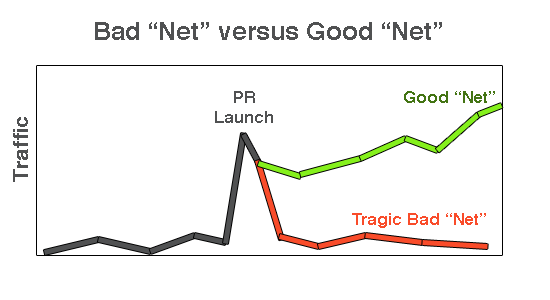Vinicius Vacanti is co-founder and CEO of Yipit. Next posts on how to acquire users for free and how to raise a Series A. Don’t miss them by subscribing via email or via twitter.
From a PR perspective, I like to think of the internet as an ocean full of schools of fish. There’s the TechCrunch school, the NY Times school, Lifehacker school, HackerNews school and thousands of others.
When one of these services feature your startup, their respective school of fish will suddenly and dramatically swim directly towards your startup. And, as fast as they come, they will swim by you even faster.
You are a fisherman, your startup is your net and your goal is to catch as many of these fish as possible.
If your net (your startup) isn’t well-built and ready for them, the fish will swim right by you and they’ll never come back. It’s tragic and a huge blown opportunity. It happens to so many startups and you can see it in their traffic.
But, some startups have built a good net and they overnight acquire thousands of new happy users.
Here’s how we made sure Yipit, a daily deal aggregator, had a good, strong net to catch as many of these potential users as possible.
“Net” Strategy Depends on Your Stage
Startups are generally in one of the following four stages.
- Stage 0: Visitors Come But Leave
- They might click around but they don’t activate into a real user. For Yipit, that means they don’t subscribe for our daily email
- Stage 1: Visitors Sign-Up But Don’t Come Back
- A visitor will like your site enough to create an account but they con’t come back. For Yipit, they pick their city and provide us their email but don’t open / click on our emails.
- Stage 2: Visitors are Retained
- Not only does a visitor sign-up, but they are coming back regularly. For Yipit, they either come back to the site to see new deals or, for most of them, they receive our email recommendations.
- Stage 3: Visitors Refer Others
- They either like your service so much they tell their friends or the service itself encourages them to refer others. We didn’t have a great way to track referrals though we could see it with google searches for “yipit” and direct navigation.
Stage 0 and Stage 1: Create Splash Page
Most startups are in stage 0 or stage 1. You should not be actively seeking PR.
Before Yipit pivoted to focus on just aggregating daily deals, we were at stage 1. Users signed-up for our service but they weren’t clicking on our emails, they weren’t using the deals we were recommending and they weren’t referring others.
So, we would direct new visitors to a splash page where they would sign-up for our waiting list. We would then invite them to the site and see if they signed-up and came back. When they didn’t, we would offer them $10 to get on the phone and explain why they didn’t like it.
We got visitors to Yipit in a bunch of different ways: meet people, google ads, facebook ads, some current users would refer new users, friends, people googling us. The fortunate thing is that you don’t need that many users to figure out what’s wrong with the service.
Every startup in stage 0 or stage 1 should build this splash page today. It’s a great source of early test users and, more importantly, you get their emails so you can follow up with them.
I recommend you use Unbounce to build it. You don’t have to have any technical background to do it. We didn’t use it because it wasn’t around but would use it today.
Some tips for the splash page:
- Have one concise, huge phrase that explains what problem your startup is addressing. For Tumblr, it’s “The Easiest Way To Blog”. For Yipit, it was “All the Best Daily Deals In Your City“
- The email sign-up form should be on the splash page
- You should A/B test it with different messages
- Have an image or video that explains what the service will do
- See About.Me’s splash page, it’s awesome. Not only do you sign-up for their waitinglist, but you reserve your username. So smart.
- Dropbox had 100,000 users just off of their splash page
Stage 2 and Stage 3: Ready For PR “Launch”
Based on our all our conversations with users, we pivoted to focusing on aggregating daily deals in February of this year.
Right away, we knew we were in stage 2. Our early users liked the new service, we liked it, they were buying deals, they were telling friends. We were ready to launch.
We made a PR push and got TechCrunch, Wired and a few other companies to cover our launch. When those users came, we converted them into our first five thousand users.
The only caveat for not launching in stage 2 is if you can quickly do a few things that will dramatically increase your referral rate (like integrating with Twitter or Facebook). If that’s the case, implement the low hanging fruit before launching since it can potentially double / triple the impact of your PR efforts.
Had we grown impatient and tried to launch before we were at stage 2, we would have crash and burned after launch.
(For more on the stages of a startup, I recommend Dave McClure’s amazing Startup Metrics for Pirates.)
Vinicius Vacanti is co-founder and CEO of Yipit. Next posts on how to acquire users for free and how to raise a Series A. Don’t miss them by subscribing via email or via twitter.







